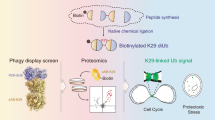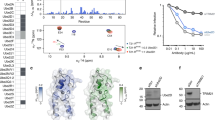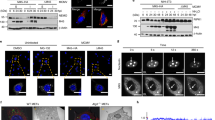Abstract
The Epstein-Barr virus nuclear antigen 1 contains a glycine-alanine repeat that inhibits in cis MHC class l-restricted presentation. We report here that insertion of a minimal glycine-alanine repeat motif in different positions of IκBα protects this NF-κB inhibitor from signal–induced degradation dependent on ubiquitin-proteasome, and decreases its basal turnover in vivo resulting in constitutive dominant-negative mutants. The chimeras are phosphorylated and ubiquitinated in response to tumor necrosis factor α, but are then released from NF-κB and fail to associate with the proteasome. This explains how functionally competent IκBα is protected from proteasomai disruption and identifies the glycine-alanine repeat as a new regulator of proteolysis.
This is a preview of subscription content, access via your institution
Access options
Subscribe to this journal
Receive 12 print issues and online access
$209.00 per year
only $17.42 per issue
Buy this article
- Purchase on Springer Link
- Instant access to full article PDF
Prices may be subject to local taxes which are calculated during checkout
Similar content being viewed by others
References
Oldstone, M.B. How viruses escape from cytotoxic T lymphocytes: molecular parameters and players. Virology 234, 179–185 (1997).
Masucci, M.G. & Ernberg, I. Epstein-Barr virus: Adaptation to a life within the immune sytem. Trends Mkrobiol. 2, 125–130 (1994).
Rickinson, A.B. & Moss, D.J. Human cytotoxic T lymphocyte responses to Epstein-Barr virus infection. Annu. Rev. Immunol. 15, 405–431 (1997).
Blake, N. et al. Human CD8(+) T Cell responses to EBV EBNA1-HLA class I presentation of the (Gly-Ala)-containing protein requires exogenous processing. Immunity 7, 791–802 (1997).
Falk, K. et al. The role of repetitive DNA sequences in the size variation of Epstein-Barr virus (EBV) nuclear antigens, and the identification of different EBV isolates using RFLP and PCR analysis. J. Gen. Virol. 76, 779–790 (1995).
Levitskaya, J. et al. Inhibition of antigen processing by the internal repeat region of the Epstein-Barr Virus nuclear antigen-1. Nature 375, 685–688 (1995).
Levitskaya, J., Sharipo, A., Leonchiks, A., Ciechanover, A. & Masucci, M. Inhibition of ubiquitin/proteasome-dependent protein degradation by the Gly-Ala repeat domain of the Epsein-Barr-virus nuclear antigen 1. Proc. Natl. Acad. Sci USA 94, 12616–12621 (1997).
Goldberg, A.L., Akopian, T.N., Kisselev, A.F., Lee, D.H. & Rohrwild, M. New insights into the mechanisms and importance of the proteasome in intracellular protein degradation. Biol. Chem. 378, 131–140 (1997).
Berg, A.A. & Baldwin, A.S.J. The IκB proteins: multifunctional regulators of rel/NF-κB transcription factors. Genet Dev. 7, 2064–2070 (1993).
Brown, K., Park, S., Kanno, T., Franzoso, G. & Siebenlist, U. Mutual regulation of the transcriptional activator NF-kappa B and its inhibitor, I kappa B-alpha. Proc. Notl. Acad. Sci USA 90, 2532–2536 (1993).
Henkel, T. et al. Rapid proteolysis of I kappa B-alpha is necessary for activation of transcription factor NF-kappa B. Nature 365, 182–185 (1993).
DiDonato, J.A., Mercurio, F. & Karin, M. Phosphorylation of I kappa B alpha precedes but is not sufficient for its dissociation from NF-kappa B. Mol. Cell. Biol. 15, 1302–1311 (1995).
Jaffray, E., Wood, K.M. & Hay, R.T. Domain organization of I kappa B alpha and sites of interaction with NF-kappa B p65. Mol. Cell. Biol. 15, 2166–2172 (1995).
Rise, N.R. & Ernst, M.K. In vivo control of NF-kappaB activation by IkappaBalpha. EMBO J. 12, 4685–4695 (1993).
Krappmann, D., Wulczyn, F.G. & Scheidereit, C. Different mechanisms control signal-induced degradation and basal turnover of the NF-kappaB inhibitor IkappaB alpha in vivo. EMBO J. 15, 6716–6726 (1996).
Wang, C.Y., Mayo, M.W. & Baldwin, A.S.J. TNF- and cancer therapy-induced apoptosis: potentiation by inhibition of NF-kappaB. Science 27A, 784–787 (1997).
Beg, A.A. & Baltimore, D. An essential role for NF-kappaB in preventing TNF-alpha-in-duced cell death. Science 274, 782–784 (1996).
Van Antwerp, D.J., Martin, S.J., Kafri, T., Green, D.R. & Verma, I.M. Suppression of TNF-alpha-induced apoptosis by NF-kappaB. Science 27A, 787–789 (1996).
Chen, Z. et al. Signal-induced site-specific phosphorylation targets I kappa B alpha to the ubiquitin-proteasome pathway. Genes Dev. 9, 1586–1597 (1995).
Brown, K., Gerstberger, S., Carlson, L., Franzoso, G. & Siebenlist, U. Control of I kappa B-alpha proteolysis by site-specific, signal-induced phosphorylation. Science 267, 1485–1488(1995).
Traenckner, E.B. et al. Phosphorylation of human I kappa B-alpha on serines 32 and 36 controls I kappa B-alpha proteolysis and NF-kappa B activation in response to diverse stimuli. EMBOJ. 14, 2876–2883 (1995).
Rodriguez, M.S. et al. Identification of lysine residues required for signal-induced ubiquitination and degradation of I kappa B-alpha in vivo. Oncogene 12, 2425–2435 (1996).
Miyamoto, S., Maki, M., Schmitt, M.J., Hatanaka, M. & Verma, I.M. Tumor necrosis factor alpha-induced phosphorylation of I kappa B alpha is a signal for its degradation but not dissociation from NF-kappa B. Proc. Natl. Acad. Sci USA 91, 12740–12744 (1994).
Lin, Y.C., Brown, K. & Siebenlist, U. Activation of NF-kappa B requires proteolysis of the inhibitor I kappa B-alpha: signal-induced phosphorylation of I kappa B-alpha alone does not release active NF-kappa B. Proc. Natl. Acad. Sci USA 92, 552–556 (1995).
Finco, T.S., Beg, A.A. & Baldwin, A.S.J. Inducible phosphorylation of I kappa B alpha is not sufficient for its dissociation from NF-kappa B and is inhibited by protease inhibitors. Proc. Natl. Acad. Sci USA 91, 11884–11888 (1994).
Alkalay, I. et al. Stimulation-dependent I kappa B alpha phosphorylation marks the NF-kappa B inhibitor for degradation via the ubiquitin-proteasome pathway. Proc. Natl. Acad. Sci USA 92, 10599–10603 (1995).
Ciechanover, A. The ubiquitin-proteasome proteolytic pathway. Cell 79, 13–21 (1994).
Yates, J.L., Camiolo, S.M., Ali, S. & Ying, A. Comparison of the EBNA1 proteins of Epstein-Barr virus and herpesvirus papio in sequence and function. Virology 222, 1–13 (1996).
Thiel, B.L., Guess, K.B. & Viney, C. Non-periodic lattice crystals in the hierarchical microstructure of spider (major ampullate) silk. Biopolymers 41, 703–719 (1997).
Simmons, A.H., Michal, C.A. & Jelinski, L.W. Molecular orientation and two-component nature of the crystalline fraction of spider dragline silk. Science 271, 84–87 (1996).
Williams, J., Williams, M., Liu, C. & Telling, G. Assessing the role of El A in the differential oncogenicity of group A and group C human adenoviruses. Curr. Top. Microbiol. Immunol. 199, 149–175 (1995).
Lin, L. & Ghosh, S. A glycin-rich region of NF-κB p105 functions as a processing signal for the generation of the p50 subunit. Mol. Cell. Biol. 16, 2248–2254 (1996).
Harrison, P.M., Bamborough, P., Daggett, V., Prusiner, S.B. & Cohen, F.E. The prion folding problem. Curr. Opin. Struct. Biol. 7, 53–59 (1997).
Baumeister, W. & Lupas, A. The proteasome. Curr. Opin. Struct. Biol. 7, 273–278 (1997).
Fisher, E.A. et al. The degradation of apolipoprotein B100 is mediated by the ubiquitin-proteasome pathway and involves heat shock protein 70. J. Biol. Chem. 272, 20427–20434 (1997).
Lee, D.H., Sherman, M.Y. & Goldberg, A.L. Involvement of the molecular chaperone Ydj1 in the ubiquitin-dependent degradation of short-lived and abnormal proteins in Saccharomyces cerevisiae. Mol. Cell. Biol. 16, 4773–4781 (1996).
Bercovich, B. et al. Ubiquitin-dependent degradation of certain protein substrates in vitro requires the molecular chaperone Hsc70. J. Biol. Chem. 272, 9002–9010 (1997).
DiDonato, J. et al. Mapping of the inducible IkappaB phosphorylation sites that signal its ubiquitination and degradation. Mol. Cell. Biol. 16, 1295–1304 (1996).
Hendil, K.B., Kristensen, P. & Uerkvitz, W. Human proteasomes analysed with monoclonal antibodies. Biochem. J. 305, 245–252 (1995).
Devary, Y., Rosette, C., DiDonato, J.A. & Karin, M. NF-kappa B activation by ultraviolet light not dependent on a nuclear signal. Science 261, 1442–1445 (1993).
Dillner, J. et al. Antibodies against a synthetic peptide identify the Epstein-Barr virus-determined nuclear antigen. Proc. Natl. Acad. Sci USA 81, 4652–4656 (1984).
Author information
Authors and Affiliations
Corresponding author
Rights and permissions
About this article
Cite this article
Sharipo, A., Imreh, M., Leonchiks, A. et al. A minimal glycine-alanine repeat prevents the interaction of ubiquitinated IκBα with the proteasome: a new mechanism for selective inhibition of proteolysis. Nat Med 4, 939–944 (1998). https://doi.org/10.1038/nm0898-939
Received:
Accepted:
Issue Date:
DOI: https://doi.org/10.1038/nm0898-939



